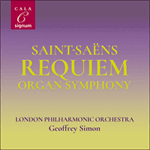
Welcome to Hyperion Records, a British classical label devoted to presenting high-quality recordings of music of all styles and from all periods from the twelfth century to the twenty-first.
Hyperion offers both CDs, and downloads in a number of formats. The site is also available in several languages.
Please use the dropdown buttons to set your preferred options, or use the checkbox to accept the defaults.





However, Liszt was by no means the only influence on the symphony. In a letter to Berger, written while it was in progress, the composer explained: ‘This imp of a symphony has gone up a semitone; it didn’t want to stay in B minor and is now in C minor.’ Two reasons for this may be suggested. First, to have left the symphony in B minor might have made too obvious the debt of the opening allegro to the beginning of Schubert’s ‘Unfinished’. Second, and perhaps more importantly, the move up to C minor/major allows the massive organ chord which launches the maestoso to be underpinned by a bottom C, the lowest note on the instrument. We can also detect a homage to Bach in the use of a chorale in the maestoso to bring all the threads together, and certainly Saint-Saëns must have had Berlioz in mind, both in basing his motto theme on the Dies irae which figures so prominently in the last movement of the Symphonie fantastique, and in the wild woodwind writing at the start of his second movement. But Saint-Saëns, like Liszt and Berlioz, saw anarchic elements as desirable only within a firmly established framework: the end of the symphony proudly proclaims C major and the survival of the social order.
from notes by Roger Nichols © 2019
Toutefois, l’influence de Liszt est loin d’être la seule exercée sur cette symphonie. Dans une lettre à Berger, écrite pendant qu’elle était en cours, le compositeur expliqua: «Cette diablesse de symphonie est montée d’un demi-ton; elle n’a pas voulu rester en si mineur, elle est maintenant en ut mineur.» On pourrait avancer deux raisons pour ce changement. Premièrement, avoir laissé la symphonie en si mineur aurait pu rendre trop évident la dette de l’allegro initial au début de la symphonie inachevée de Schubert. Deuxièmement et, peut-être plus important encore, la montée à ut mineur/majeur permet à l’accord massif de l’orgue qui lance le maestoso d’être étayé par un do grave, la note la plus grave de l’instrument. On peut aussi déceler un hommage à Bach dans l’utilisation d’un choral au sein du maestoso pour rassembler toutes les idées, et Saint-Saëns devait certainement penser à Berlioz, à la fois en basant son motif thématique sur le Dies irae, qui joue un rôle si important dans le dernier mouvement de la Symphonie fantastique, et dans l’écriture déchaînée pour les bois au début de son deuxième mouvement. Mais Saint-Saëns, comme Liszt et Berlioz, ne jugeait souhaitable la présence d’éléments anarchiques qu’au sein d’un cadre fermement établi: la fin de la symphonie proclame fièrement ut majeur et la survivance de l’ordre social.
extrait des notes rédigées par Roger Nichols © 2019
Français: Marie-Stella Pâris
Liszt war jedoch keineswegs der einzige Einfluss auf die Sinfonie. In einem Brief an Berger, den er während des Schaffensprozesses schrieb, erklärte der Komponist: „Dieser Kobold von Sinfonie ist einen Halbton hochgegangen; er wollte nicht in h-Moll bleiben und steht nun in c-Moll.“ Hierfür könnte es zweierlei Gründe geben. Zunächst einmal wäre die Ähnlichkeit des Eröffnungssatzes Allegro zu dem Beginn von Schuberts „Unvollendeter“ wohl zu offensichtlich gewesen, wäre die Sinfonie in h-Moll geblieben. Zweitens, und vielleicht noch wichtiger, erlaubt der Wechsel nach c-Moll/C-Dur den gewaltigen Orgelakkord, mit dem das Maestoso eingeläutet wird, so dass das Ganze von einem tiefem C—der tiefste Ton des Instruments—untermauert werden kann. Zudem wird eine Hommage an Bach deutlich, wenn er in dem Maestoso einen Choral verwendet, um alle Fäden zusammenzuführen. Und schließlich muss Saint-Saëns Berlioz im Kopf gehabt haben, da er seinem Motto-Thema nicht nur das Dies irae zugrunde legte, welches in dem letzten Satz der Symphonie fantastique so prominent hervortritt, sondern auch den zweiten Satz mit wilden Passagen für die Holzbläser beginnt. Ebenso wie Liszt und Berlioz betrachtete Saint-Saëns anarchische Elemente jedoch nur innerhalb eines fest abgesteckten Rahmens als wünschenswert: am Ende der Sinfonie wird C-Dur und damit der Fortbestand der Gesellschaftsordnung stolz kundgetan.
aus dem Begleittext von Roger Nichols © 2019
Deutsch: Viola Scheffel
 Saint-Saëns: Requiem & Organ Symphony Saint-Saëns: Requiem & Organ SymphonyOne of a pair of distinctive Saint-Saëns recordings made with the London Philharmonic Orchestra, this album features the rarely recorded Overture to La princesse jaune and the expansive Requiem.» More |

